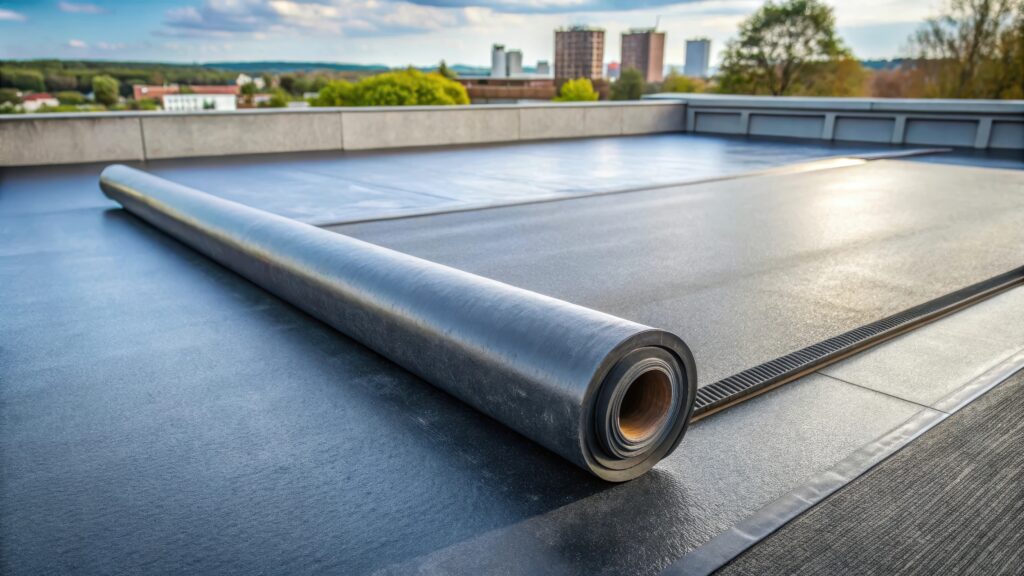EPDM
Roofing
Ethylene Propylene Diene Monomer (EPDM) is a type of synthetic rubber commonly used in commercial roofing. It is renowned for its durability, flexibility, and exceptional resistance to weathering, ozone, UV radiation, and extreme temperatures. These qualities make it a reliable choice for flat and low-slope frameworks, where long-lasting performance is essential.
At Maximum Construction, we specialize in providing high-quality commercial roofing solutions tailored to meet the unique needs of each building. We prioritize safety, timely project completion, and transparent communication to deliver reliable results that keep your business running smoothly.

Key Characteristics and Benefits
Here’s an overview of the key characteristics and benefits of EPDM:
Chemical Composition
EPDM is a synthetic rubber made from three main components: ethylene, propylene, and a diene monomer. Ethylene and propylene form the polymer backbone, providing flexibility and resistance to weathering. Meanwhile, the diene component enables cross-linking during vulcanization, which strengthens the material.
Thicknesses
Commercial roofing membranes are typically manufactured in three standard thicknesses:
- 45 mil (0.045 in): thin and lightweight, often used in smaller or less demanding installations
- 60 mil (0.060 in): the most common thickness, balancing durability with cost-effectiveness
- 90 mil (0.090 in): thicker and more robust, used in high-traffic or harsh exposure areas for added protection and longevity
Available Forms
EPDM membranes come in several forms to suit different project needs:
- Black: This standard form is highly durable and absorbs heat.
- White: This coating or material is designed to reflect sunlight, reducing surface temperature and enhancing energy efficiency.
- Reinforced: This features a polyester fabric embedded within the rubber, enhancing its tensile strength and puncture resistance.
- Non-reinforced: This is composed of pure rubber sheets without reinforcement, providing greater flexibility but lower mechanical strength.
Installation Types
There are three main installation methods for this type of commercial roofing:
- Fully adhered: The membrane is glued directly to the substrate using adhesives. This method provides excellent wind uplift resistance and is ideal for complex layouts.
- Mechanically attached: The rubber is fastened to the deck using screws and plates. This is faster and usually more cost-effective but may be less airtight if not installed correctly.
- Ballasted: The membrane is loosely laid over the deck and secured in place by heavy materials, such as gravel or pavers. This method is quick but adds weight to the structure and is less common in modern commercial installations.
Factors To Consider When Using EPDM on Commercial Buildings
Below are considerations if you’re considering this type for your commercial property:
- Roof Size and Slope
EPDM is most effective on flat or low-slope commercial roofs, typically those with a slope less than 3:12 (14°). For steeper ones, it may not perform as well due to constraints on water runoff speed and adhesion. The surface size also impacts the material cost, as larger buildings require more membrane.
- Climate Conditions
Assessing local climate factors helps determine if standard rubber or specialty formulations are necessary. For example, white or reflective membranes are preferred in hot regions to reduce heat absorption and lower cooling costs.
- Building Usage
Commercial buildings with heavy equipment or frequent foot traffic require a durable roofing membrane. Warehouses or manufacturing facilities with rooftop HVAC units or solar panels should consider reinforced options for added puncture resistance and longevity.
- Budget Constraints
The material offers a competitive balance of upfront cost and long-term value. Installation costs are generally lower than those of some alternative membranes, such as PVC or TPO, especially for large surfaces. However, budget planning should include potential maintenance and repair expenses.
- Warranty and Installer Certification
A comprehensive manufacturer’s warranty is crucial for protecting the investment in any system. Warranties often cover membrane defects and material failures but usually require professional installation to remain valid and enforceable.
Start Planning Your Upgrade
If your commercial roof is aging or showing signs of wear, now is a good time to start planning an upgrade. A well-executed roofing project can extend the life of your building and reduce long-term maintenance costs. Maximum Construction is ready to help you assess your current system and plan the next steps with confidence.
Contact us to schedule your roof assessment!
